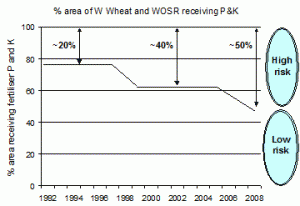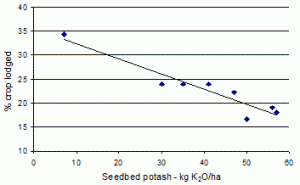Download pdf: Missed applications of potash put arable crops at risk (228.60K)
pdf 228.60K
Missed applications of potash put arable crops at risk
March 2010

Recent booklets and press articles in Britain have given advice on management guidelines for winter wheat and on how to avoid flat crops, but often with little mention of the fundamental need for balanced nutrition. Most of the discussion centres around nitrogen (N), which one publication describes as “the most important nutrient”. As Liebig taught us over 150 years ago, no nutrient is the most important. All are essential, and the first to be in short supply will be the one to become limiting. It may be true to say that nitrogen is the most difficult to manage, but it is no more important than the other essential nutrients, nor is it necessarily required in the greatest quantity by the growing crop – this is usually the prerogative of potassium! One recent publication does provide an appropriate caveat in its introduction saying it assumes that all manageable constraints on N responsiveness have been identified and remedied.
However it appears from surveys that these constraints may not be being addressed by all growers. Figure 1 suggests that more than 50% of the GB area of winter wheat and winter oilseed rape crops in 2007/08 did not receive a dressing of phosphate or potash. Historically, as can be seen, it was the practice to limit this non-application to about 20% of the area, probably crops which followed a good and well fertilised break crop.
If a crop cannot take up the potash it requires from the soil in sufficient quantity at the time it requires it (for its structural growth and to provide the K needed in the cell sap of all new growth) this will slow its growth rate. Thus it will not require all the available N so carefully provided, and will not perform to its full potential. Nitrogen use efficiency will be reduced and N losses (inc. GHG) increased.
Risk of lodging is greater if potash levels are low

Potassium significantly affects the strength of straw through its influence on lignification and cell wall thickness. Any deficiency of potash will reduce straw strength and increase the risk of lodging. This is illustrated by PDA measurements in wheat crops at different levels of potash application over two years (Figure 2). It is clearly essential that to get the best from the use of plant growth regulators (PGRs) a crop must not be suffering from a lack of potash.
Yield and Nopt affected by soil K status
Figure 3 shows the effect of K deficiency on both grain yield and the optimum N fertiliser rate of a spring barley crop grown at Rothamsted. Not only did the very low soil K level (Index 0) cause a major reduction in yield, but it also halved the optimum N rate. In practice, if the crop had been expected to yield at the 100% rate probably half of the recommended N applied would have been wasted.

As was mentioned in an earlier PDA Newsletter the large K uptake by crops is particularly required as the osmoticum in plant cell ‘sap’ – it causes the cells to absorb water by osmosis and thus become rigid so that the unlignified leaves stand up. If there is a limited supply of K in the soil, or the reserves are so low that the rate at which it is released is too slow, then the plant will effectively stop creating new cell tissue, and its productive potential will not be achieved, as is demonstrated in Figure 3.
Top-dressing winter crops with potash in spring
On soils with low potassium reserves (K Index 0 or 1) it is recommended that potash fertilisers are incorporated into the seedbed. However if for some reason this has not been done, and winter-sown crops have not yet received a dressing of potash, it is still beneficial to top-dress with potash in the early spring rather than to omit the dressing altogether. Application can be as straight potash, or as an NK or NKS product, whichever is the most convenient. Soils with K Index 2 can be dressed at any convenient time, with an application designed to replace the K removed in the crop – i.e. a ‘maintenance dressing’ to maintain the soil K reserve.
Penalties of K deficiency
- Serious yield loss especially in adverse growing conditions e.g. dry summers.
- Weaker growth resulting in higher lodging risk.
- Lower crop vigour giving greater susceptibility to disease, pests and weed competition.
- Poor grain sample – low grain size, poor specific and 1000 grain weights, more tailings.
- Inefficient N uptake and utilisation leading to poor N response and less protein synthesis.
- Adverse effect on marketability.
- Lower tolerance to physiological stress – wet, drought, frost, wind.

